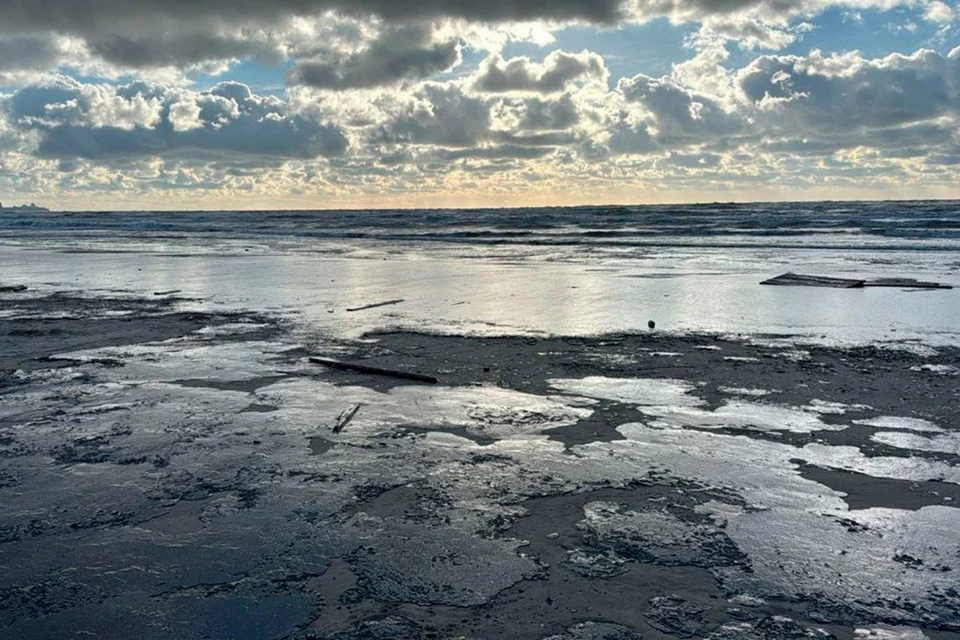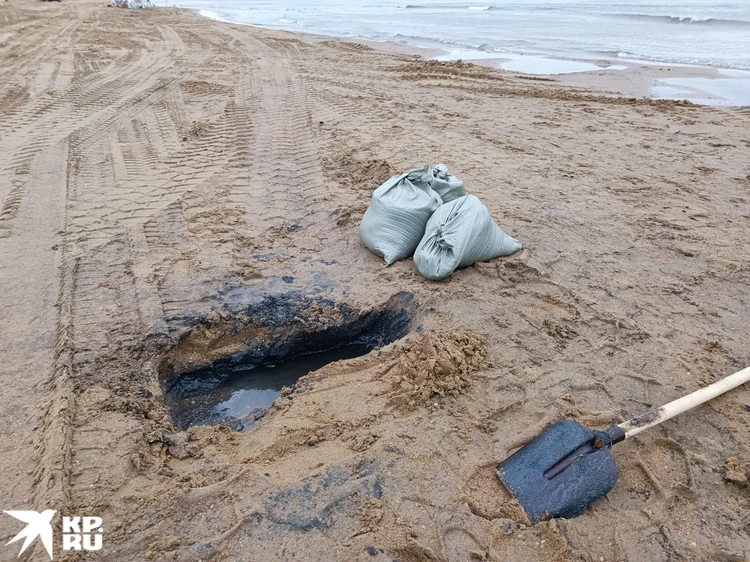The world's first incident involving "heavy" fuel: What ecological damage was caused by the oil spill in the Black Sea?
 7
7This is what the beaches of Anapa looked like on December 17, during the oil spill on the shore. Photo: Evgeny Grigorenko
“What kind of primitive method is this for cleaning beaches from oil? Is there really no more technological experience in the world for cleaning?” Admit it, you thought the same when reading the news about the tragedy that occurred. It was completely unclear why the volunteer-shovel-bag was almost the only way to eliminate the poison on the coast. To find answers, I traveled to Anapa and became that volunteer with improvised means, while also speaking with specialists about the ecological damage to the area.
To remind, on December 15, two tankers, “Volgoneft 212” and “Volgoneft 239,” sank in the Kerch Strait during a severe storm. A powerful wave broke the long platforms in half, damaging some of the tanks containing oil. According to the Ministry of Transport, 2400 tons spilled into the sea. On December 17, some of the poison was washed ashore near Anapa, Temryuk, and Kerch. The contaminated area stretched along the coast for 54 km.
 8
8A bag and a shovel are the main tools for eliminating the ecological disaster
Photo: Natalia Varsegova. Go to the Photo Bank KP
HEAVY, VISCOUS, AND SMELLY
After a thorough inspection of the wrecked vessels, the Ministry of Transport determined that four tanks (containers) of oil were damaged. The others remained intact. In turn, specialists from the Marine Rescue Service stated: “The emergency in the waters of the Kerch Strait is the first in the world involving ‘heavy’ fuel oil of grade M100.”
For reference. Fuel oil is a type of fuel obtained from heavy residues of oil, coal, and shale processing. It is typically used in boilers for energy generation, shipping, and industry. By itself, it is very heavy, viscous, and, pardon me, very smelly.
From the Telegram channel of the Ministry of Transport: “Such fuel oil solidifies at a temperature of +25, with a density almost like water and heavier. Therefore, unlike other petroleum products, it does not float to the surface but settles to the bottom or floats at various depths. There are no proven technologies for its removal from water in the world. Thus, the primary method is collection from the shoreline when the oil is washed ashore by waves.”
Unfortunately, the damage from the sinking of the two tankers in the Kerch Strait will continue to grow. This is the opinion of the chairman of the All-Russian Society for the Protection of Nature (VООП), the first deputy chairman of the State Duma Committee on Ecology, Natural Resources, and Environmental Protection Vyacheslav Fetisov.
- We know that there is an underwater current that can bring many surprises, - he said at a press conference on December 25.
- The fuel oil consists of different fractions: heavy, medium, and light, - adds co-chairman of the “Green” party Sergey Shakhmatov. - It is clear that the heavy fraction settled to the bottom, which is the main part of the spilled volume. Consequently, all biodiversity of the bottom sediments in this area has perished. The medium fraction is still migrating within the water area. This includes the coastal part of the Taman Peninsula and Crimea, reaching into the Kerch Strait. Depending on the changes in water temperature, the density of the water will change, and portions of the heavy and medium fractions will rise. All of this will be washed ashore, depending on the direction of the wind and the current.
 9
9Volunteers are loading bags of contaminated sand
Photo: Natalia Varsegova. Go to the Photo Bank KP
UNTIL BACTERIA EAT IT
Ecologist Zhory Kavanossyan checked at what temperatures the oil would rise to the surface of the water. It turned out that at temperatures of 23-24 degrees, the viscosity decreases, and oil stalagmites begin to form at the bottom of the container. At 25 degrees, it starts to float.
- Such temperatures occur in the Black Sea up to depths of 15-20 meters in summer, - he explains in his Telegram channel @ecozhora. - The entire narrow coastal shelf area near Anapa (from Cape Panagia to the Anapa Marine Station) and the entire southern part of the Kerch Peninsula (up to Feodosia) has depths of up to 20 meters. This means that all the oil that settled to the bottom in these areas will start to float in summer, turning back into emulsion and washing ashore. At the same time, Igor Shkradyuk, an expert from the “Wildlife Protection Center” and a specialist in industrial ecology, believes that oil can remain in seawater for a month to several years until it is consumed by bacteria.
But why was Anapa flooded with emulsion in the first days, and later the waves washed up viscous clumps?
- In the first days, the oil was warm. It was heated in the tankers. Then it solidified in the cold, - replies Zhory Kavanossyan.
 0
0Heavy machinery collects filled bags and takes them to landfills
Photo: Natalia Varsegova. Go to the Photo Bank KP
WHAT IS THE DANGER?
Oil consumes oxygen in the water, reducing the food base, and is ingested by fish and other marine inhabitants. The “Delph” center reported that as of January 5, 32 dolphins had been found dead from the fuel spill.
- Judging by the condition of the bodies, most likely the majority of these cetaceans died in the first 10 days after the disaster. And the sea continues to wash them ashore, - the message from @delfacenter states. - The most affected were the Azov dolphins, which have always been the most vulnerable cetaceans. We expect an increase in the number of affected cetaceans to be much greater than usual in the coming months. Our main task now is to prepare as much as possible for this moment and organize a station for providing long-term assistance to the injured.
During the monitoring of the dolphins, experts discovered that there are many pollutants in the area of Anapa and its nearby regions, with extensive areas where oil floats in clumps within the water column, along with an oil slick on the surface.
 1
1A pile of sand contaminated with oil at the mouth of the Mozhepsin River will be cleaned at a landfill
Photo: Natalia Varsegova. Go to the Photo Bank KP
WHEN URGENCY IS APPROPRIATE
- We have time until summer, - warns the ecologist. - It is necessary to clean the bottom at least in areas with depths of up to 20 meters. Otherwise, in summer, we will face emissions like thick oil cream on the sand. It is essential to quickly devise a methodology for cleaning the bottom, to collect the clumps of oil and conglomerates in the seaweed. Otherwise, we will be back to working with shovels in summer, washing birds.
Expert Sergey Shakhmatov outlines the main steps for eliminating the emergency situation:
First, we need to pump out the remaining oil from the sunken tankers. (And for this, a unit that was brought from St. Petersburg has already been tested, - Ed.).
Secondly, locating and extracting the heavy fractions that have settled to the bottom, as well as finding and disposing of the medium fractions that are still migrating in the middle layers of the sea. (This is actively being done by specialists from the Marine Rescue Service. They find pollution on the water and treat the spots with sorbent, - Ed.).
Thirdly, addressing the collection issue. It doesn’t matter if it’s soil, sand, or water with bottom sediment.
- In my estimates, this is approximately one million cubic meters of contaminated soil, - explains Sergey Shakhmatov